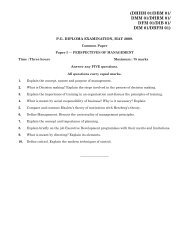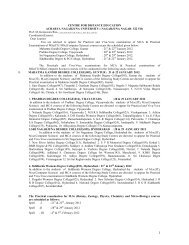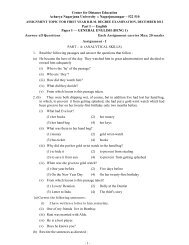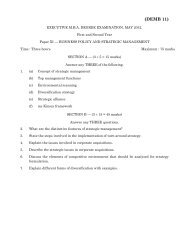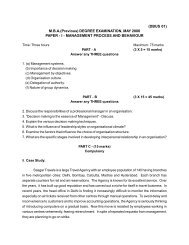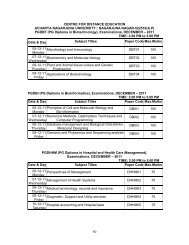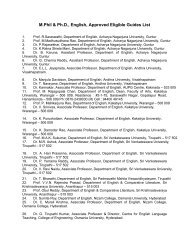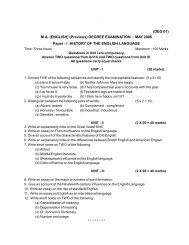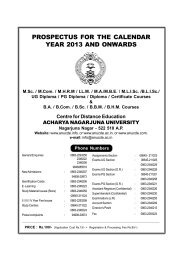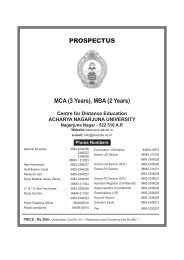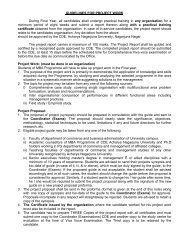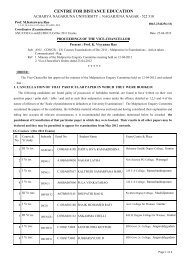II YEAR - ANUCDE
II YEAR - ANUCDE
II YEAR - ANUCDE
- No tags were found...
Create successful ePaper yourself
Turn your PDF publications into a flip-book with our unique Google optimized e-Paper software.
(DBUS 21 NR)Time : Three hoursM.B.A. DEGREE EXAMINATION, MAY 2012.Second YearPaper I — FINANCIAL MANAGEMENTSECTION A — (3 × 5 = 15 marks)Answer any THREE of the following.Maximum : 75 marks1. (a) ABC analysis.(b)Financial intermediaries.(c)(d)(e)(f)Capital rationing.Financial leverage.Operating cycle.Opportunity cost of capital.SECTION B — (3 × 15 = 45 marks)Answer any THREE of the following.2. How should the finance function of an enterprise be organised? What functions do thefinancial officer perform?3. ‘‘The MM thesis is based on unrealistic assumptions’’. Evaluate the reality of theassumptions made by MM.4. What is a stable dividend policy? Why should it be followed?5. Explain the costs of liquidity and illiquidity. What is the impact of these costs on thelevel of current assets?6. Two forms A and B have the following information :Sales Variable costsRs. in LakhFixed costsFirm A : 1800 450 900Firm B : 1500 750 375
You are required to calculate(a)(b)(c)Profit to sales ratioBreak-even point andThe degree of operating leverage for both firms.Comment on the positions of the firms. If sales increase by 20 percent what shallbe the impact on the profitability of the two firms.7. A company is currently selling 1,00,000 unit of its product at Rs. 50 each unit. At thecurrent level of production, the cost per unit is Rs. 45. Variable cost per unit being Rs.40. The company is currently extending are months credit to its customers. It is thinkingof extending credit period to two months in the expectation that sales will increase by 25percent. If the required rate of return (before tax) on the firms investment is30 percent, is the new credit policy desirable?8. Case study :SECTION C — (15 marks)(Compulsory)Money company has outstanding 50 lakh shares selling at Rs. 120 per share. Thecompany is thinking of paying dividend of Rs. 10 per share at the end of the currentyear. The capitalisation rate for the risk class of this firm is 10 percent. UsingModigliani and Miller’s model you are required : (a) to calculate the price of the share atthe end of the current year if dividends are paid and if they are not paid. (b) todetermine the number of shares to be issued if the company earns Rs. 9 crore, paysdividends and makes new investments of Rs. 6.60 crore.——————
M.B.A. DEGREE EXAMINATION, MAY 2012.Second Year(DBUS 21 OR)Time : Three hours1. (a) Equity share capital(b)(c)(d)(e)(f)Return on InvestmentZero based BudgetCash flow statementOptimum capital structureInventory control.Paper I — FINANCIAL MANAGEMENTPART A — (3 × 5 = 15 marks)Answer any THREE of the following.PART B — (3 × 15 = 45 marks)Answer any THREE of the following.Maximum : 75 marks2. When can arise a conflict between shareholders and managers goals? How does wealthmaximisation goal take care of the conflict?3. Explain the merits and demerits of the time-adjusted methods of evaluating theinvestment projects.4. What is a statement of changes in financial position? How does it differ from funds flowor cash flow statement?5. How would you apply the cost of capital concept when projects with different risks areevaluated?6. The following is the balance sheet of Venson Ltd., as on 31.03.11.LiabilitiesEquity capital(Rs.10 per share)Amount(Rs)AssetsAmount(Rs)1,80,000 Fixed assets 4,50,00010% debentures 2,40,000 Curren assets 1,50,000Retained earnings 60,000Current liability 1,20,0006,00,000 6,00,000
The company's total assets turnover ratio is 2.5 times. The fixed operating cost are Rs. 2lakhs. Variable operating cost ratio 40 percent. Income tax rate is 50 per cent.(a)Calculate the leverages(b) Determine the likely level of EBIT if EPS is Rs. 67. Gokul plastics currently provides 20 days of credit to its customers. Gokul's presentsales are Rs. 9 lakhs. The contribution margin ration is 0.25 per cent. Gokul isconsidering extending its credit period by 10 days, such an extension of credit increasessales to Rs. 10 laksh at the same time it involves 5 per cent bad debt loss on new sales.Calculate the change in net profit(residual income) with the assumption of 40 percent tax and cost of capital is 12 per centand also suggest that the Gokul should implement the proposed extension of creditperiod? Give reason, and also increases the bad debt portion on new sales would be 5 %suggest whether the company consider the relaxation of credit standards or not.8. Case Study:PART C — (15 marks)(Compulsory)The following is the date regarding two companies ‘X’ and ‘Y’ belonging to the sameequivalent rise class:Company X Company YNo of ordinary shares 90,000 1,50,000Market price per share Rs. 1.20 Rs. 1.006% debentures 60,000 -Profit before interest Rs. 18,000 Rs. 18,000All profit after debenture interest are distributed as dividends. You are required toexplain how under modigliani and miller approach, an investor holding 10% of shares incompany ‘X’ will be better off in switching his holding to company ‘Y’.—————————
Time : Three hoursM.B.A. DEGREE EXAMINATION, MAY 2012.Second YearPaper <strong>II</strong>–OPERATIONS MANAGEMENTSECTION A– (3 × 5 = 15marks)Answer any THREE of the following(DBUS 22)Maximum : 75 marks1. (a) Waste Management.(b)(c)(d)(e)(f)Intermittent Production SystemQuality assuranceValue engineeringABC analysisSimulationSECTION B– (3 × 15 = 45marks)Answer any THREE of the following2. List out and explain various decision areas of operations management.3. How do the major layout concerns very between Job shop and line processing layouts?4. Describe the process of production planning and control in a manufacturing concernwhich undertakes production according to order.5. Explain how a capacity alternative can be selected from among several alternatives.6. Discuss the various types of material handling equipments that are used in a lightengineering industry.7. Who should be responsible for Inventory control? Discuss your statement from adepartmental as well as top management point of view.
8. Note: Separate sheet enclosed.SECTION C– (15marks)(Compulsory)The following table gives the result of inspection of 20 samples of 100 items eachtaken on 20 working days. Draw a p–chart. What conclusion do you draw from thechart about the process?SamplenumberNo ofdefectivesSamplenumberNo ofdefectives1 6 11 102 2 12 43 4 13 64 1 14 115 20 15 226 6 16 87 10 17 08 19 18 39 4 19 2310 21 20 10——————
Time : Three hours1. (a) Demographic segmentation.(b)(c)(d)(e)(f)Personal setting.Product StrategiesFull cost pricingConsumer BehaviourIdea marketing.M.B.A. DEGREE EXAMINATION, MAY 2012.Second YearPaper <strong>II</strong>I — MARKETING MANAGEMENTSECTION A — (3 × 5 = 15 marks)Answer any THREE of the following.SECTION B — (3 × 15 = 45 marks)Answer any THREE of the following(DBUS 23 NR)Maximum : 75 marks2. ‘‘All organisations need marketing’’. Do you agree to this statement? If so, give reasonsin support of your answers.3. What is market segmentation? Explain the bases for market segmentation?4. Discuss sheth model of buyer behaviour. How does it help in understanding decision –making process of consumers?5. Briefly describe each of the four main stages of the product life cycle.6. What are the factors influencing pricing strategies and policies?7. Write about channel selection under distribution mix of marketing?8. KEEBOR SHOES LIMITEDSECTION C — (15 marks)CompulsoryThe Indian sports shoe market is estimated at 25 million pairs per annum and isgrowing at an annual rate of 25 percent. The Indian shoe market is heavily crowdedwith numerous brands. There is a sudden rush of foreign brands into this market. Inless than a year three international bands viz. LOTTO, PUMA and ADIDAS haveentered the Indian market. Bata has tied up with Adidas; Carona Limited with Pumashoes and Consolidated Footwear with Lotto.
According to a survey, 5 million pairs of smuggled sports shoes are sold in the countryevery year indicating the Indian consumer’s interest and craze for foreign labels. CaronaLimited has a capacity to manufacture 3 million pairs of sports shoes and Bata Limiteda capacity of 4 million pairs per annum. The plants have not yet attained full capacity.Power is the market leader and action has carved out a niche for itself through itslifestyle promotion strategy Puma-Carona and Lotto emphasise on their foreignconnections and technological perfection. They also have plans to Sponsor sports events,institute sports awards are scholarships, and have sportsmen endorse their brand.BUYER PROFILE AND BEHAVIOURThe profile of the sports shoe buyer is that of a male who is under 30 years of age, who isa student or earning member with a reasonably high family income of above Rs. 10,000per month atleast. The awareness of both Indian and foreign brands, among the buyersis quite high. Most of the sports shoe buyers intend to use them as a regular all-timewear or as occasional casual wear, while a very small proportion uses them for playinggames only. Superior technology, better appearance and brand image are consideredmore important reasons than suitability for games for buying a particular brand ofsports shoes.PRODUCT, PRICE AND DISTRIBUTIONPuma is available in maximum number of models; Lotto is available in fewer numberand Adidas the least. The price ranges from Rs. 500 a pair for the low priced to Rs. 1,200per pair for the high priced. Buyers of sports shoes for the purpose of playing games onlygenerally opt for the low priced shoes. The concept of high quality and high priced shoeshas not gained acceptance in India.Puma is available at a large number of company showrooms and private outlets, Adidasat a selected company owned outlets and a few private outlets, Lotto at a large numberof Bata stores and other private outlets. In all, 79 percent of all shoe outlets sell sportsshoes. Shops selling Adidas/Puma/Lotto derive 31 percent of their turnover from thesports shoe business.Keebor is the highest priced sports shoe in the world. It is the market leader in sportsshoes. Keebor has decided to enter the Indian Market on its own having no collaborationwith any of the Indian shoe brands. Keebor would like to achive a sales target of 5 lakhpairs of sports shoes per annum in India.Questions(a)(b)What is the target market segmentation possible for Keebor shoes? Which segmentshould it choose? Why?Elaborate upon the marketing mix Keebor shoes must design to position itself inthe identified target market?——————
(DBUS 23 OR)Time : Three hoursM.B.A. DEGREE EXAMINATION, MAY 2012.Second YearPaper <strong>II</strong>I — MARKETING MANAGEMENTSECTION A — (3 × 5 = 15 marks)Answer any THREE of the following.Maximum : 75 marks1. (a) Marketing mix(b)(c)(d)(e)(f)Market positioningPsychological pricingDirect marketingFamily brandingSales forecasting.SECTION B — (3 × 15 = 45 marks)Answer any THREE of the following.2. Discuss the significance of marketing in a developing economy.3. Explain how macro and micro environment are influencing as marketing strategyof a company.4. Define and discuss the nature and scope of consumer behaviour.5. Classify products with suitable examples. State their features.6. How do you assess the effectiveness of advertising?7. How do you resolve conflict between different channels of distribution?
SECTION C — (15 marks)(Compulsory)8. Note:Case Study:Indian Pharmaceuticals was established in 1985 to manufacture, distribute andmarket pharmaceutical drugs. The company established a place for itself inpharmaceutical industry in India.In 1995, the Managing Director of the company stressed the need fordiversification and addition of new products to its existing product range. Lookingat the success of the Triveni brand of high protein biscuits, he floated the idea ofmanufacturing and marketing the biscuits rich in protein, minerals and vitamins.His advisors suggested that since most of the people in the country were sufferingfrom protein deficiency such products enriched with protein would be desirableand should be a big success specially inview of its competitors brand. Themarketing research department also gave green signal to the project afterconducting brief survey the company promoted its biscuits with the triple plusprotein brand name. It was supplied in a 400gm. packet consisting of 60 biscuits atthe price of Rs. 75. The product was heavily advertised in the news papers, healthmagazines, radio and television. The target audience was middle class who it wasbelieved suffered most from protein deficiency and can afford Triple plus proteinbiscuits. The ordinary biscuits were available in the market at the rate of Rs. 30 toRs. 40 per kg. The thrust of Triple Plus biscuits in the promotion campaign wasthat these biscuits contain three times more protein and have additional mineral
and vitamin value. The company has 50 stockists covering the entire country andhas a sales force of about 150 medical representatives for promoting its productsthrough doctor and registered medical practitioners. The medical representativesof the company had very good rapport with Government and charitable hospitals.To promote the Triple Plus brand of biscuits, its medical representatives gavediscount coupons to doctors for passing over to their patients. The buyers wereentitled to Rs. 5 per packet of 400 gms, the scheme continued for about 6 months.Despite heavy advertising and canvassing by its medical representatives, theproduct was unable to attract customers. It was observed that the launching ofthis product has not affected the market position of Triveni biscuits at all whichwas being sold at Rs. 90 for a pack of 275 gms. Rather, it was observed that thesale of Triveni biscuits have increased marginally consequent to the advertisementcampaign by the India pharmaceuticals. The company could achieve only 25% ofits sales target in the first year and it remained almost static for the next year.Questions:(a) What are the reasons for the failure of the company to achieve its sales target?(b) Critically evaluate the advertising and sales promotion strategy followed.(c) Suggest suitable promotion plan which can increase the sales of the company.—————
(DBUS 24 NR)M.B.A. DEGREE EXAMINATION, MAY 2012.Second YearPaper IV — HUMAN RESOURCE MANAGEMENTTime : Three hours1. (a) Job Design.SECTION A — (3 × 5 = 15 marks)Answer any THREE of the following.Maximum : 75 marks(b)(c)(d)(e)(f)Human resource planning.Psychological test.Career planning.Job satisfaction.Collective bargaining.SECTION B — (3 × 15 = 45 marks)Answer any THREE of the following.2. Evaluate clearly the significant development of Human Resource Management in Indiain the recent past.3. Examine the objectives and methods of job analysis.4. Describe the factors influencing Recruitment and explain the various sources ofRecruitment.5. What are management development programmes? Explain.6. What is the significance of Disciplinary procedure? Give a brief account of Disciplinaryprocedure.7. Discuss upon the functions and methodologies followed by the trade unions in today'scontext.
SECTION C — (15 marks)CompulsoryEMPOWERMENT IN ACTION8. Talking about taking action reminds me of a specific example that exemplifies whathappens when a team member has been empowered. I had been on a grueling speakingtour when, after an arduously long flight, I checked into the Meridien Hotel, New Delhi,at 2.00 am. Because it was late, I gave the car keys to a bellman so that I could getchecked in and go to bed. The following morning I had an early engagement with aclient. After breakfast I gave my claim check to an attendant. After waiting for aboutfive minutes, Hari, the bellman, came back and told me that my car would not start. “Itappears”, he explained, “that someone left the lights on overnight.” Given that I had anappointment with a very important client, I started getting a bit nervous. “Not to work,Dr. Rakesh.” (Those Meridien hotel folks have figured out how important our names areto us — I just wonder why most other service companies have not caught on) “I’ll justdrive you to your appointment in our an and get you these in plenty of time.” On the wayover, he told me that he would contact the car rental company and make sure that theycorrect the problem or provide me with another car. (Mind you, he came up with that, Ididn’t ask for it.) “Also he continued, “what time would you like me to pick you up?” Iassured him that I would be able to get a ride back, but that I would be extremelygrateful if he could make sure that the car would be fixed, since I would have littlechange to do it myself. At the end of a full and demanding day, I returned to the hotel, Icould hardly believe it when I found out that Hari had indeed taken care of everything.And to think, all I had given him was the name of the car rental company ! Plus, he wasincredible cheerful and composed at all times. A front-line employee taking independent,autonomous action to do right by the customer regardless of effort, inconvenience orcost. That’s what I call empowerment in action !Questions:(a) What prompted the bellman take care of every problem of Dr. Rakesh?(b) What factors contributed to the extraordinary performance of the bellman?(c) What benefit did the hotel Meridien derive from Hari’s action?————————
Time : Three hours1. (a) Human Resource development(b)(c)(d)(e)(f)InductionJob descriptionFringe benefitsEmployee disciplineM.B.A. DEGREE EXAMINATION, MAY 2012.Second YearPaper IV — HUMAN RESOURCE MANAGEMENTSECTION A — (3×5 = 15 marks)Answer any THREE of the followingWorkers participation in managementSECTION B — (3×15 = 45 marks)Answer any THREE of the following(DBUS 24 OR)Maximum : 75 marks2. What is meant by manpower planning? Outline the various objectives of manpowerplanning.3. what are the different methods of training? Write advantages and disadvantages of anyone of the methods of training of your choice.4. Why do we appraise performance of employees and what methods are used to do this?5. The various statutory measures needed for the employee welfare seldom achieve thepurpose? Do you agree? Give reasons.6. “Justice delayed is justice devided”. Comment with reference to the handling ofgrievances.7. With increasing recognition being given to the integrative approach to collectivebargaining, trade union militancy in India is an a downslide comment.
SECTION C — (15 marks)CompulsoryHINDUSTAN CHEMICAL LTD8. The Hindustan Chemicals Ltd (HCL) is a public sector firm engaged in petrochemicalbusiness. It employs about 1,600 most of whom arewell-qualified, fairly young (average age 32) and typically have an urban background.HCL has retained one reputed consulting and training organization each to imparttraining in supervisory skills for their junior managers, human resource managementProgrammed with emphasis on organization analysis and behaviour modification skillsfor middle managers and advanced management programmes for senior managers. HCLwanted to train all managerial employees over a period of 12 to 15 months in batches of20 per months at junior and middle levels and 20 senior managers in once every twomonths.IAM, a renowned management institute was assigned the responsibility to covermiddle managers.A couple of months after the start of the training intervention, the topmanagement learnt of a growing tendency on the part of some of the employees on nightshift to sleep while on duty. Since it was a tightly manned petro-chemical complex anynegligence or dereliction of duty in certain critical areas could be potentially hazardousand extremely risky. Therefore, the Director (Personnel) and a couple of members of thetop management team went around the plant one night, without any prior informationto the plant people about their visit. They caught red handed, four persons sleeping onduty, recorded evidence and proceeded with taking steps to initiate disciplinary actionthe following day. When the charge sheets were being prepared, trade union leadersdescended on the scene, persuaded the top management to be lenient, as an exception inthis case, to the concerned persons. The union leader also assured that they wouldadvise their members not to sleep while on duty. In the interest of maintaining goodindustrial relations, the top management did not pursue the cases.This gesture on the part of the top management was perceived as a sign of theirweakness by the officers’ association and its members. They protested to topmanagement whether they (the latter) would be equally considerate in cases involvingthem (the managers). The workers felt that so long as there is no problem in the plant,management would be considerate enough. With the result, the incidence of sleeping onnight duty began to grow. Top management became alarmed. The PersonnelDepartment was asked to advise all line managers, particularly left in-changes in nightduty to keep a vigil on those who have a tendency to sleep and report cases of personswho are found guilty of sleeping on duty. The circular did not register any impact on themiddle and junior managers. Instead, they derisively laughed and ignored the circulars.They also felt that “the top management’s perception of industrial relations dynamics atthe plant is very different from that of junior and middle level managers.”
Seeing no improvement in the situation, the top management asked IAM toinclude a module on Handling Indiscipline with role play sessions on ‘How to conductDomestic Enquiry’. The Programme Coordinator readily agreed to the suggestionbecause he felt that in doing so he was making it tailor-made to the needs of theorganization.When the module was first offered to the fifth batch of middle managers, theparticipants wondered why this subject was additionally introduced. They wanted toknow why it did not from an integral part of the programme from the colleagues whoattended the programme from the beginning itself and whether the need for includingthe topic was felt by their colleagues who attended the programme in the previousbatches or by the top management. When they learnt that it was at the latter’s instance,they stoutly protested in chorus and said, “We know the importance of Discipline. Infact, with growing violence our physical security is often threatened due to sabotage,violence and vandalism by a handful of unruly elements. Discipline, therefore is notmerely an organization need, but also a personal need for us whereas for the topmanagement it is a bargainable aspect of shop-floor industrial relations. What we needis not training but proof that top management means what it says. We demand that thetop management supports and sustains the actions we initiate in maintaining discipline.We will be able to have confidence in top management if it, shows us the way by firstinitiating actions on the cases they themselves have booked.”Such restiveness affected the receptivity in what was on the agenda in the trainingschedule for that afternoon. But the trainees became intensely involved the followingday when they were doing the organization analysis in small groups. Most participantswondered what happened to the suggestion their predecessors made while presentingthe findings of their group discussions on organization analysis before some members ofthe top management team on the last day of every programme held thus far. Oneparticipant asked: our colleagues gave their feedback to the top management. Weunderstand the latter agreed on most points. But we see no evidence of follow-up of anykind. “A second one argued with the programme coordinator, “Why are you asking us togive vent to our feelings? Do you realize that our top management is merely using youand the other faculty as a buffer. A third one queried, of personality and situation. Nowtell us whether top management is merely wanting to change our personality but doesnot want to change the situation. We do not know whether discussion on aspectsconcerning their personality should remain a taboo since projection will not help us.”Questions:(1) Discuss the key issues in this case. Identify the lessons for developing trainingstrategies. What remedial steps would you suggest in this Case?——————
(DBUS 25)M.B.A. DIPLOMA EXAMINATION, MAY 2012.Second YearPaper V — RESEARCH METHODOLOGY FOR MANAGEMENT DECISIONSTime : Three hoursSECTION A — (3 × 5 = 15 marks)Answer any THREE of the following.Maximum : 75 marks1. (a) Differences between a management decision problem and a marketing researchproblem.(b)(c)(d)(e)(f)Pre test -post test control group design.Criteria to be used when evaluating secondary data.Sign test.Difference between principal component analysis and common factor analysis.Prediction accuracy.SECTION B — (3 × 15 = 45 marks)Answer any THREE questions2. What is the role of the researcher in the problem definition process? Describe andevaluate experimental designs and the differences among pre-experimental, trueexperimental quasi experimental and statistical designs.3. Distinguish between primary and secondary data. Distinguish between probability andnon- probability sampling techniques. Describe the probability sampling techniques.4. Describe the non-comparative scaling techniques. Describe the notion of internalconsistency reliability.5. Describe the significance of preliminary data analysis and the insights that can beobtained from such an analysis. Explain data analysis associated with cross tabulationsand the associated statistics.6. Distinguish between parametric and non –parametric tests. Discuss the similaritybetween cluster analysis and discriminant analysis. Explain various clustering methods.
7. Explain the basic requirements of report preparation. What is the purpose of an oralpresentation? What guide liens should be followed in an oral presentation.SECTION C — (15 marks)Compulsory8. A Survey of 320 families with 5 children even revealed theNo of boys 0 1 2 3 4 5No of girls 5 4 3 2 1 0No of families 12 40 88 110 56 14Is this result consistent with the hypothesis that the male and female births areequally probable?———————
(DBUS 26)Time : Three hoursM.B.A. DEGREE EXAMINATION, MAY 2012.Second YearPaper VI — BUSINESS POLICY AND STRATEGIC MANAGEMENT1. (a) Explain about 7.S framework.(b)(c)(d)(e)(f)PART A — (3 × 5 = 15 marks)Answer any THREE questions.What is the rationale of performing a SWOT analysis?How can a strategic budget be prepared?What are the characteristics of a mission statement?How is a strategic advantages profile prepared?What do you mean by corporate restructuring?PART B — (3 × 15 = 45 marks)Answer any THREE questions.Maximum : 75 marks2. What are the drawbacks of being a specialist? What are the advantages of being ageneralist?3. What are the basic functions and responsibilities of the senior management?4. What points need to be kept on mind while using a particular source of environmentalinformation?5. Exemplify how commitment to past strategic actions may restrict the strategic choice fora firm.6. How is a top-down approach different from the bottom-up approach for resourceallocation?7. Enumerate the different structural mechanism required to implement a strategy.8. Case study.PART C — (15 marks)Compulsory.In the 2000s, telecommunications (telecom) company Bharti Airtel Limited (BAL) wasthe market leader in the Indian telecom market. It had established itself as the leader in
the market by differentiating itself with its focus on building a strong brand throughinnovation in sales, marketing, and customer service, and an innovative cost effectivebusiness model. Analysts also credited BAL with negotiating the regulatory hurdles inthis emerging market and competition very effectively. This enabled it to becomeprofitable despite the Indian telecom market having the lowest tariffs in the world.Some analysts opined that BAL’s unique business model had become the benchmark foremerging markets. Mobile telephony in India was experiencing the fastest growth in theworld and India was already one of the leading markets in terms of mobile subscriberbase. Despite Average Revenue per User (ARPU) figures in the country being quite lowcompared to many other markets, it was viewed as an attractive market as mobilepenetration of the market, particularly in the huge rural areas in India, was still low.With the developing market in the West reaching high levels of saturation (70% in USand 100% in some European markets), many global telecom operators were looking atemerging markets for their growth and this made India a prime target market for thesefirms. The market in India was also expected to witness many changes with theintroduction of new technologies and mobile number portability.Since 2007, BAL had been facing serious threats to its leadership position. On the onehand, there was the onslaught from global players such as Vodafone and Virgin Mobile,and on the other, the threat from established Indian companies such as RelianceCommunications Ltd.. Tata Teleservices Ltd., and the state-owned Bharat SancharNigam Ltd., (BSNL). Moreover, the market was expected to witness the entry of somemore Indian and foreign companies. BAL had responded to investing heavily inexpanding its network, technology, and marketing. It was trying to cover all segments ofthe population-from the tech-savvy youth population who coveted the latest Value-Added Services (VAS) to the Bottom of the Pyramid (BoP) segment who would besatisfied with a low-cost offering.In early 2008, BAL, which still dominated the Indian telecom market and was theworlds tenth largest telecom company, was also readying itself to replicate its successstory in some other emerging markets.Questions:(a)(b)(c)How Bharti Airtel Ltd., tapped the opportunities in the Indian telecom sector andestablished itself as the market leader.Analyze the booming telecom sector in India that was experiencing high growthrates, with special emphasis on the competitive landscape in the sector.What are the opportunities that emerging markets such as India offer to globalbusiness enterprises.————————
(DBUS 27)M.B.A. DEGREE EXAMINATION, MAY 2012.Second YearPaper V<strong>II</strong> — MANAGEMENT OF INFORMATION SYSTEMSTime : Three hoursSECTION A — (3 × 5 = 15 marks)Answer any THREE of the followingMaximum : 75 marks1. (a) Information systems(b) Data communication concept(c) Query Language(d) Data flow diagrams(e) Hardware(f) Executive support systemSECTION B — (3 × 15 = 45 marks)2. What do you understand by the concept of Information Resource Management? Explain.3. What is system Development life cycle? Explain.4. Outline the recent trends in Information Technology in India.5. What do you understand by RDBMS? Explain6. Write a note on computer networks.7. What will be the future of DBMS?
SECTION C — (15 marks)8. Case Study: (Compulsory)The Universal Food and Drinks Limited (UFDL) is a Company, manufacturing differenttypes of packaged foods and drinks. The product range consists of more than 50 itemsand 200 packaging units. The Company's products and popular throughout the countryand the company is known for its quality procucts.The universal Foods and Drinks Limited has processing plants in the various parts ofthe country like Jammu and Kashmir, Madhya Pradesh, Himachal Presesh,Maharashtra, and Kerala. It has a wide network of distributors and dealers, who stockthe UFDL products and deal with all types of customers. The Company, through thisnetwork,. reaches. to over 50,000 retail points in the urban and the rural markets.Some of the products of the UFDL are produced throughout the year and are soldthrough this wide network. Some products are seasonal in production but are soldthroughout the year. And some products are popular in certain seasons and not Indemand at all in the other seasons.The business performance of the company is assured good, if the UFDL produces theproducts as per the varying demand pattern of the customers. Since the company hasestablished its strength in the distributor dealer network, the success comes through theappropriate decisions in the purchase of fruits, vegetables, cereals and pulses andputting them through processing and packaging, and despatching them to the variouslocations where the distributors are located.It is the policy of the company to launch each year at least one new product in thecountry. This policy has paid rich dividends, to the company in terms of its image andthe customers have always looked forward for such an announcement from theCompany’s end. The UFDL uses, well in advance, the different advertising media suchas the newspapers., hoardings, magazines, sample tests and demos, T.V., etc. forannouncing and promotion of its new products from time to time. However, the selectionof the media is based on the product and its overall position in the product range and thetargeted market segment.In spite of the considerable strength in many aspects of business, the Company hasfailed in the launching of new products. It was also not able to meet the demand owingto the inadequate purchases of raw materials, the wastage of the raw material as theprocessing plant Of the Company was not available due to its maintenance schedule orit was scheduled for some other food processing operation. The Company also faces theproblems of high seasonal inventory which, if not disposed off in time, becomes a nonmovingand sometimes a non-saleable inventory.
The UFDL has its Marketing Division headed by a Manager-Marketing supported bythe Product Manager for a group of its products.Questions:(a)(b)(c)Identify the different decisions which the Management of the company is makingduring the course of the business execution.Classify these decisions in terms of the types certainty, risk and uncertainty.Which of these decisions cab be converted into the programmable decisions? Give amodel of one programmable decision, and suggest a decision support system (DSS)for the same.——————



